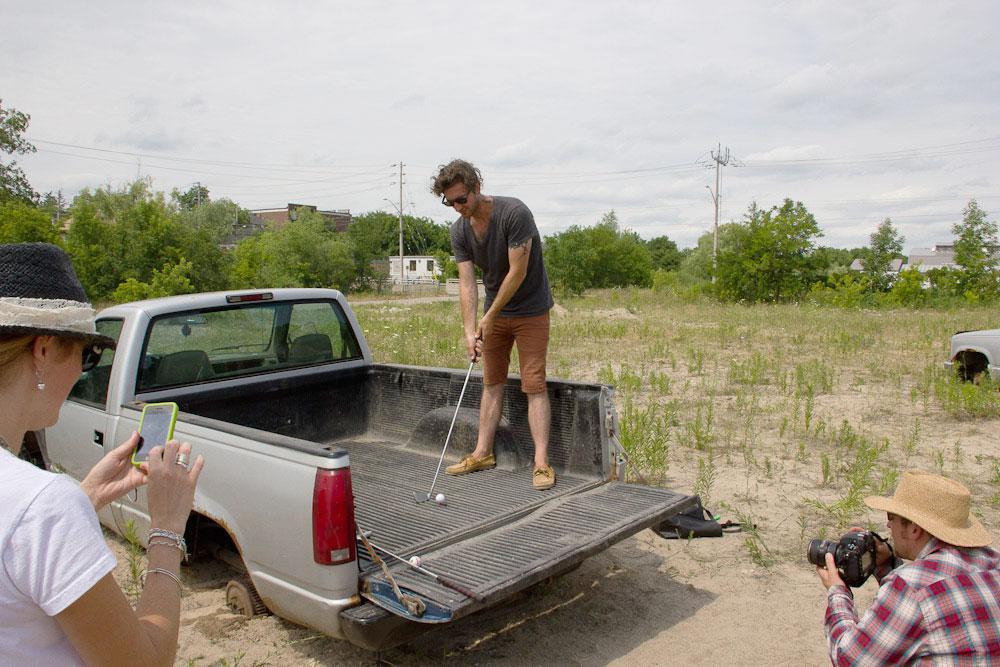Minigolf is not what first comes to mind when thinking about contemporary public art. However, Cambridge Galleries curators Iga Janik and Esther E. Shipman appropriate the game and combine it with public art and landscape architecture to reimagine urban space. The nine-hole course and landscape installations currently included in “Common Ground” take over downtown Cambridge to produce an alternative route that heightens awareness of public space as one walks through the city.
The two-part exhibition tees off on the front lawn of Cambridge Galleries’ Queen’s Square location with Barr Gilmore’s Preferred Lies. Drawing from his family history, Gilmore covers his green with tartan-patterned artificial turf, combining it with a larger-than-life golf ball and tee that paradoxically find a home on the miniature course. Gilmore’s sculpture resembles the exaggerated designs that often populate minigolf courses, and it integrates an aspect of regular golf as well by mapping out a fairly straightforward shot.
Curator Iga Janik voices similar interests when discussing the initial spark for this project. Janik was first drawn to examining the problematic nature of the game of golf, particularly its monetary and social exclusivity. By utilizing minigolf as a form of social art, Janik reverses the dynamics of the sport, inviting all members of the community to play. “Mini Golf – a social practice,” as her nine-hole portion of the “Common Ground” project is titled, acts as a device through which visual artists examine community space and create engaging public art.A few holes and a short walking tour away, a rainbow-painted pipe arches over a pile of organized rubble. Jess Perlitz’s Pipe Rainbowinitially elicits excitement—yet moments into playing, it causes frustration, as one needs to shoot upwards to make the hole. Participants are drawn in by the symbolism of a rainbow stretched over rubble, which also seems to speak to the utopic ideals often embedded in social art. Instead of serving as the culmination of a social practice, or the pot of gold at its end, Pipe Rainbow stimulates conversation.
Walking along PLANT Architect’s route also takes the participant past Lee Goreas’ risky Straight and Narrow and Julie René de Cotret’s playful Raccoon Mischief. It also takes viewers all the way out to the furthest minigolf hole, created by Derek Liddington. Liddington’s The moment prior to the execution of Anthony Caro framed by the setting sun. Oh, how romantic. plays up a kind of violence embedded in the game of golf. The backs of two old pickup trucks in a dusty lot serve as the tee-off for a hole blocked by an orange and yellow minimalist sculpture. As for many of these works, completing the hole or obtaining a hole-in-one requires the player to let go of preconceived notions of the game. For this work, a successful hole-in-one occurs after hitting a white square on the sculpture, assaulting the work and ignoring the flagged hole.Curator Esther E. Shipman brings another element to “Common Ground” which works symbiotically with Janik’s game. “3ByLAND” involves the work of three landscape architecture firms; each have produced both an installation at Cambridge Galleries’ Design at Riverside location and a public artwork around the city. PLANT Architect’s CHANNELLED BURIED MOVED LOST draws attention to the partially covered and filled Mill Creek and to the history of this once-vital waterway. Composed of a walking tour along the creek and its former path, the installation includes 10 blue dots at various sites along the way; these share information gleaned from the city’s archives.
Through minigolf and architectural interventions, “Common Ground” carries out a rethinking of social space and our relationship to it. The project invites the surrounding community to participate in the project throughout the summer, engaging with the works at many different levels. The works create a platform on which diverse groups may come together in productive conversation about the city around them. Just outside of downtown Cambridge, Rare Charitable Research Reserve hosts another hub of “Common Ground” where “3ByLAND” participants, University of Waterloo architecture students and other partners have installed small interventions in the landscape. The student projects range from a summer-long project of erecting a modern longhouse to the creation of a partially enclosed field of empty chairs. Each site focuses on creating a design that takes into consideration and works with the surrounding environment.









